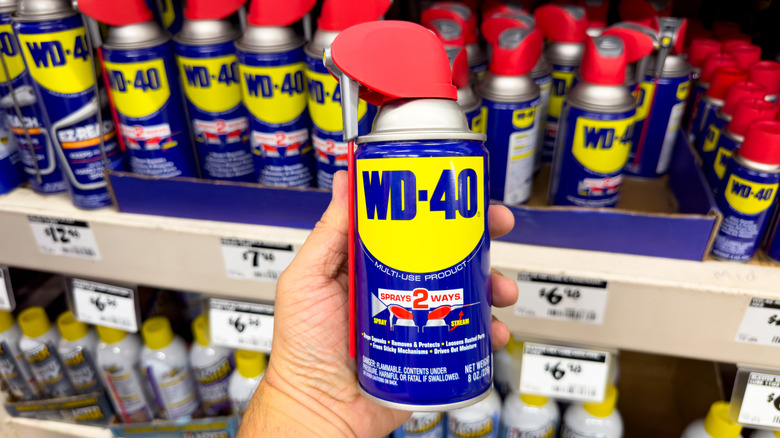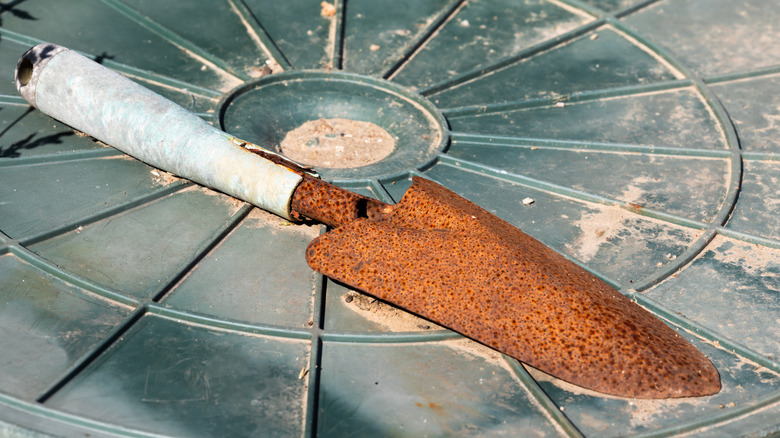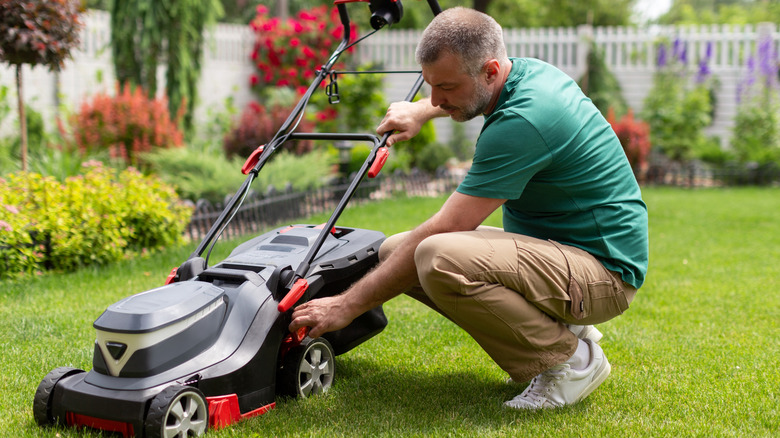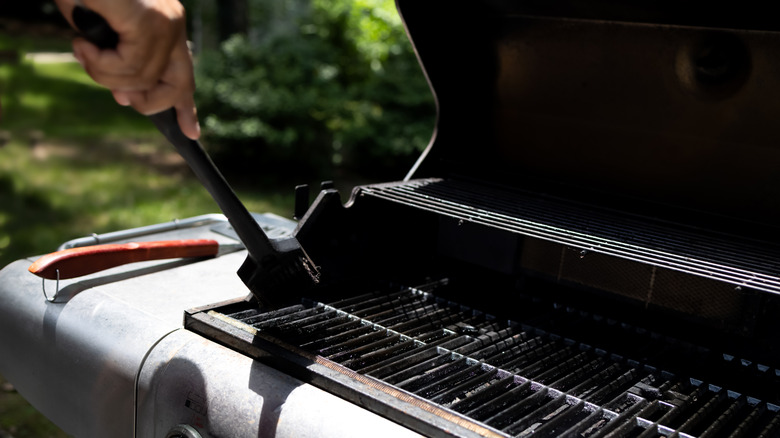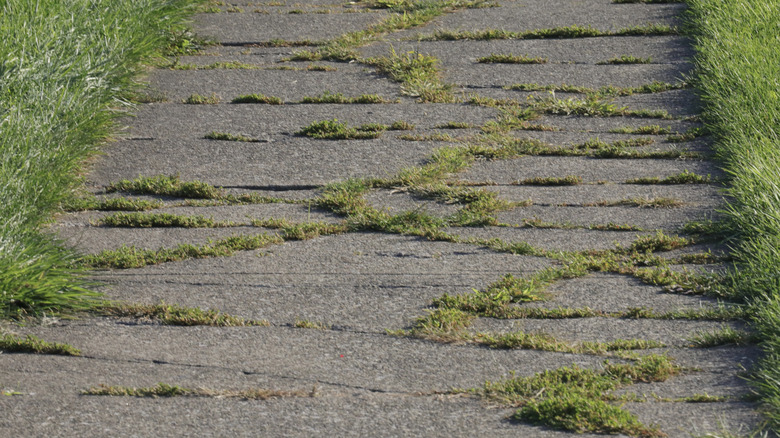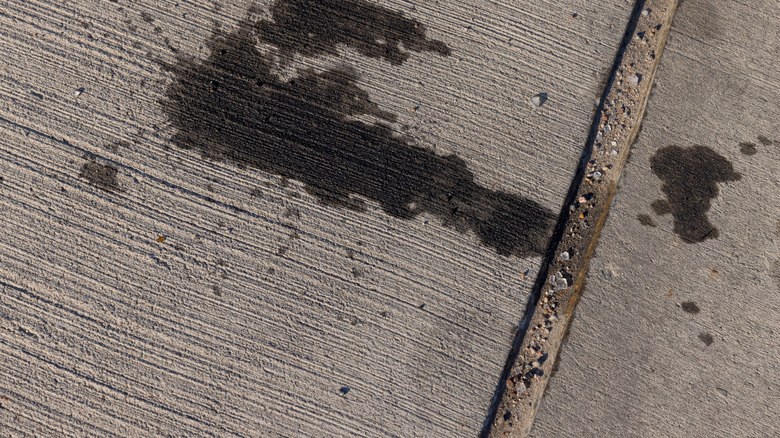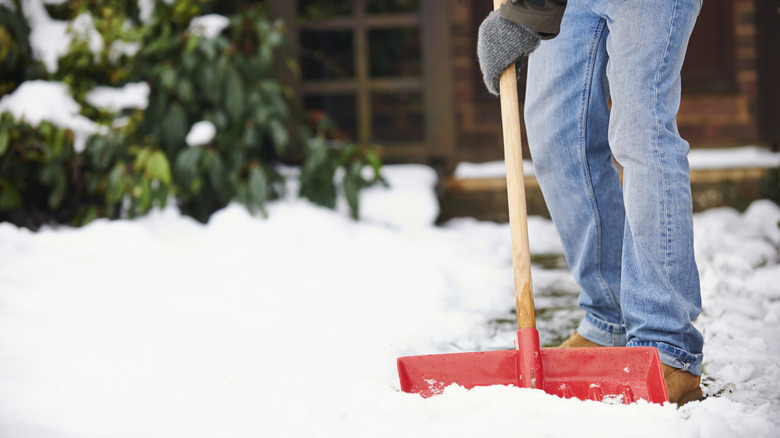Handy Ways To Use A Can Of WD-40 In Your Yard And Garden
We may receive a commission on purchases made from links.
When you're dealing with squeaky metal pieces, the chances are that a can of WD-40 Multi-Use Product is the first thing you think of. The act of spraying this product on door hinges is a well-known trick to both eradicate the awful squeaking sound while also improving the function of these types of metal components. The product is both a lubricant and anti-corrosive, which was initially invented to help prevent corrosion while removing surface rust. WD-40 gets its namesake from inventor Iver Norman Lawson, who is said to have perfected the formula on his 40th attempt.
However, if you have a can of WD-40 gathering dust as it awaits its next loud hinge, there are other great ways you can use the product. These aren't unauthorized uses, either — as the company that makes it boasts there are more than 2,000 known uses for WD-40 spray. Among some of these uses include gardening and yard tool maintenance, as well as addressing certain stains. Keep in mind that such uses are for the original spray can versions only, while a larger project may require bottled industrial-strength WD-40 products instead.
Let's check out these fun WD-40 uses, but with one caveat: Please use WD-40 with caution around children, pets, and plants, as this multi-use product can be toxic. Also, be sure to follow all of the manufacturer's safety guidelines before use.
WD-40 helps clean and maintain your gardening tools
Whether you have a full vegetable garden or just a few flowers, it's important to clean your gardening tools properly and keep them in good shape so they can work effectively when you need them. As such, WD-40 may be just the solution you need for a quick clean on hand shovels, pruners, hoes, rakes, and more. The ingredients are thought to quickly remove grime and dirt buildup from these tools, to ensure they will work their best. What's more, regular use may help prevent moisture, dirt, and corrosion from building up on metal components, so you may potentially extend the life of your must-have gardening companions.
Before spraying on the WD-40, scrub as much dirt and grime off the metal components of your gardening tools as you can. A hard bristle brush can help with this process, so the WD-40 can penetrate as close to the metal as possible without wasting any product. Next, spray an even amount of WD-40 and allow to sit for a few minutes. Use a clean rag or towel to remove excess product, and repeat if necessary. For best results, consider using this WD-40 trick any time you're your gardening tools have buildup, so they maintain both their effectiveness and longevity.
Keep your mower in good shape throughout the year with WD-40
A lawn mower is important in helping you maintain your yard while also keeping grass healthy, so your family can enjoy your outdoor spaces all summer long. However, it's also important to maintain your lawn mower so it can better help you maintain your yard. Thankfully, some of the same benefits WD-40 offers for keeping handheld gardening tools in good shape also apply to lawn mowers: That talented can of lubricating spray not only helps keep mower blades functioning, but it can also help keep grasses and other debris from sticking to them. The product is also important in preventing rust and corrosion during the off-season when you are not mowing as often.
Whether you're removing debris or rust on your lawn mower, simply spray the metal components with WD-40. Wipe the product and any debris clean with a thick cloth or rag. If you're getting ready to store your mower away for the winter, clean your lawn mower per usual and then spray WD-40 along the undercarriage to help prevent it from rusting. When lawn mowing season starts again, you can spray WD-40 to the blades before use so that grass doesn't stick to them. Doing so will keep the blades sharp and increase overall efficacy of your lawn mower.
Remove surface rust from outdoor furniture with WD-40
When you have any metal items that are stored outdoors, some level of rust accumulation is inevitable. Also known as iron oxide, rust forms as a chemical reaction when metal is exposed to water and oxygen. The problem is, you might not want to drag all your patio furniture inside every time it rains, which means a bit of rust maintenance is required on your part. This is where WD-40 can again come to the rescue. It's believed that the anti-corrosive properties can remove surface rust stains without causing damage to metal or paint.
To handle rust accumulation on your rusted patio furniture, spray WD-40 directly onto the surface at hand. Wait for at least 10 minutes and scrub the rust with a hard-bristle brush. Wipe off any remaining residue with a clean cloth, and not water. Once you've done this, enjoy another perk of the process — that is, the lubricating qualities of WD-40 can also offer short-term rust prevention on these items. That said, if you're looking to restore furniture or yard tools that have succumbed to deep, deep rust damage, you may need to try the WD-40 Specialist Rust Remover Soak product instead of the regular spray can.
Use WD-40 to clean your grill (but with caution)
The grease and grime removal capabilities of WD-40 can go beyond gardening tools and patio furniture. In fact, this versatile can may even help you clean your grill, too. While not a substitute for the occasional deep grill cleaning that you may need to do at the beginning of every season, WD-40 can be helpful when you're short on time and have to remove built-on grease and food debris on the rack. You can also use WD-40 to get rid of rust build-up on your grill, thanks to its lubricating ingredients.
Here's the one thing to be careful of: You should spray WD-40 onto the appliance only when it is completely cool. Fire safety is important.
You can also remove the rack and place on top of old towels before spraying. Allow the product to sit for up to 10 minutes before scrubbing with a grill brush or ball of aluminum foil. Also, while WD-40 can remove grease and grime, keep in mind that this product is not safe when it comes into direct contact with food. Therefore, you will also need to wash the solution away with soap and water before you start cooking food on the rack. Wipe the rack and any other components dry with a cloth, or allow them to air dry.
Address occasional weed problems in a pinch with WD-40
Maintaining a healthy lawn requires safe and consistent weed control throughout the year. This also includes removal of weeds before they flower and spread. While WD-40 is certainly not any form of herbicide, it may work against small weeds you might find in your yard or garden.
The product isn't marketed for this purpose directly, but you may have heard of its weed-killing potential as an alternative remedy. How does this work? Most likely, it's because of WD-40's chemical composition that allows it to displace water, hence preventing weeds from thriving any further. The catch here is to spray each weed with a small amount of the product, and not to use WD-40 in large areas of your lawn or garden. You can think of WD-40 as sort of a spot treatment for occasional weeds that pop up. Be careful not to spray other plants that may be nearby, as you might accidentally damage these, too. As such, you might not want to spray WD-40 on weeds before watering your lawn so that you can prevent the product from running off into plants and grasses.
You'll also need to be careful using this technique if you have pets, as petroleum-containing products can be toxic to animals and wildlife. For best results, allow the WD-40 to completely dry before allowing your pets into your yard, and remove the weeds by hand once they start to wither after applying the product.
WD-40 will remove small oil stains from a concrete patio
Oil spills are a pretty common problem, on your driveway or garage, but if you use any gas-powered yard tools such as mowers, it's possible for oil spills to occur on your backyard patio, as well. Other oil spills can result from activities like grilling or using tiki torches. Before you go through the work of using a pressure washer, though, you might just be able to save a bit of time and effort with a quick spray of WD-40. Just as the product may help with degreasing garden tools, yard equipment, and your grill, WD-40 may help lift the stain for easy removal.
The key to this hack is to use WD-40 as soon as you notice the oil stain. Spray a liberal amount of product, ensuring you cover the entire spot. Let the product sit for several minutes before scrubbing with a brush and rinsing with water. Next, you can apply baking soda to help clear any residue left behind. This last step will ensure you remove all WD-40 from the concrete, so you do not inadvertently stain your patio with the product.
WD-40 can help with snow removal
If you live in an area that is susceptible to snow accumulations, you also know how important it is to remove snow so that your family isn't stranded at home. Unless you've already invested in a high-tech snow-shoveling alternative, you probably also know the struggle of shoveling snow, and how it always seems to stick when you're trying to get it off the blade. WD-40 can help, if you spray it on to keep the shovel lubricated. Using this technique can dramatically decrease the frustration of dealing with snow that keeps sticking to everything.
What's the correct application? Well, before shoveling snow from your patio or walkways, spray the blades of your snow shovels with a liberal amount of WD-40 to prevent snow from sticking to them. It's as simple as that. You may also want to keep a can on you to reapply the product to your snow shovel, as needed, in case the effect wears off. Once the porch, walkway, and stairs are all cleared off, you should consider following up your snow shoveling session with a sprinkling of salt, to prevent ice from accumulating on your walkways.
